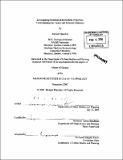Investigating mothballed brownfield properties : understanding the causes and potential solutions
Author(s)
Blanchet, Richard J
DownloadFull printable version (3.148Mb)
Other Contributors
Massachusetts Institute of Technology. Dept. of Urban Studies and Planning.
Advisor
Lavea Brachman.
Terms of use
Metadata
Show full item recordAbstract
An interview survey with 14 participants representing large corporations, non-profit organizations, regulatory agencies, and law firms was performed to determine the barriers to redeveloping brownfield properties and the proposed policies that might reduce the likelihood of mothballing properties. Based on these interviews, two overarching factors leading to mothballing include the on-going threat of liability for past disposal practices and land values that are too low to make assessment and cleanup an economically viable option for the disposition of a mothballed brownfield property. Even though federal and state statutes were amended to facilitate assessment and cleanup of contaminated property, the specter of the strict liability scheme enshrined in the environmental statutes in the 1980s still haunts corporate owners. Land values are also an important consideration for large property owners. If the sale of the property cannot at least pay for the assessment and cleanup of the property, site owners are less likely to sell the property and prefer to mothball until economic conditions are more favorable. Large property owners need to realize that the regulatory climate of the 1980s is no longer applicable in light of the amendments to federal and state environmental statutes and the enactment of new federal and state brownfield regulations. (cont.) These new brownfield regulations have a respectable record of completing brownfield cleanup and reuse projects with little recourse to re-openers. For sites located in areas where property values are low, newly available financial incentives including tax credits for remediation costs, lower-cost insurance policies to cover remaining long-term concerns, and better application of engineering and institutional controls can all help manage long-term risks to sellers while improving the economics for a property transaction. The underlying premise here is that risk can be managed and need not, necessarily, be eliminated altogether. This approach to cleanup balances multiple considerations, including costs, public health risk, end use, community acceptance, and technical feasibility.
Description
Thesis (S.M.)--Massachusetts Institute of Technology, Dept. of Urban Studies and Planning, 2005. Includes bibliographical references (leaves 54-56).
Date issued
2005Department
Massachusetts Institute of Technology. Department of Urban Studies and PlanningPublisher
Massachusetts Institute of Technology
Keywords
Urban Studies and Planning.